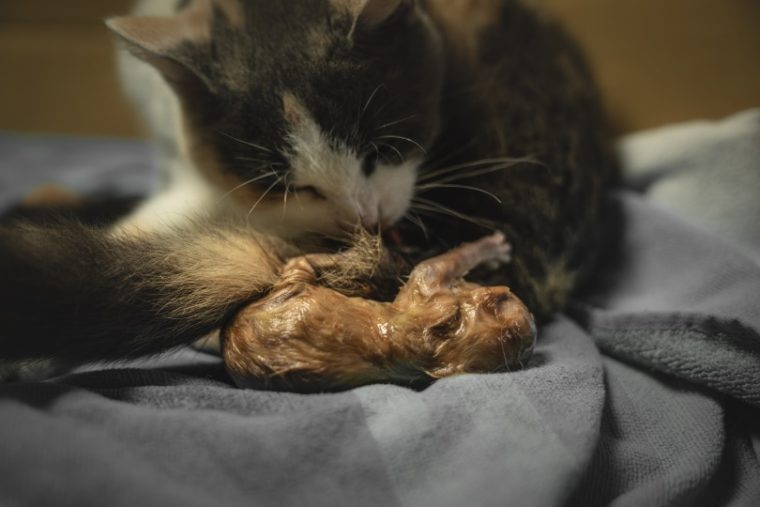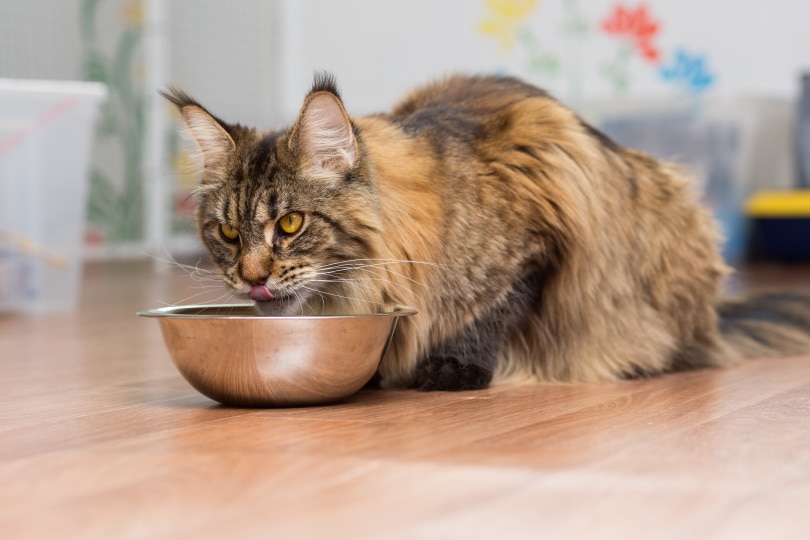
Expecting kittens is an exciting time! Generally, queens can go through the delivery process without human intervention; however, we must be prepared to assist if she needs us. In this article, we will share some knowledge about the stages of labor, the materials you should have on hand, what to look for to make sure everything is fine, the signs that something is not right, and what you can do to help. Let’s get started!
The Right Diet
Once you have confirmed your cat is pregnant, providing appropriate nutrition is very important. She will need the extra calories and energy to support the formation and nurturing of a whole litter of kittens inside her womb. Change her to a calorie-dense kitten formula during her pregnancy. During the last trimester of her pregnancy, when the growing kittens occupy the abdominal cavity space, feed multiple smaller portions several times a day to help her maintain her nutrition and calorie intake.

Signs of Imminent Labor
The feline gestation period can range between 58–70 days, most lasting between 63–65 days. You will notice the abdomen is larger, and the nipples are bigger and have changed to a darker or pink color during the last few weeks.
Supplies Checklist

Temperature Control
If you live in a cold area, you might need additional heat sources to make sure the kittens do not get too cold. The box temperature should be kept between 85–97°F during the kittens’ first two weeks of life as they can not control their body temperature by themselves.
If you use a heating pad, please note it has to be a special one for pets. Ensure that you follow safety instructions and that the temperature is not too hot. You will need to place several layers between the pad and the kittens. Never place kittens (or any other animal that can not move away from the pad) in direct contact with a heating pad to protect them from getting burn injuries. It is best to place a towel over the heating pad, then only half of the nesting box over it. Then, place several layers of towels inside the box. By placing only half of the nesting box over the heating pad there will always be a colder area inside the box where the kittens can move to if they get too hot.
A bottle with slightly warmed water covered with a towel can also aid in regulating the temperature but it should be kept at 97°F or cooler, so you will need to check it regularly.
The Birthing Process
Before we proceed to explain the birthing process, you must understand that the best way you can help is by not intervening unless it is absolutely necessary. By giving the queen and kittens space and observing from a distance you will avoid creating unnecessary stress for the queen. This will help the birthing process go smoothly.
Uterine contractions will increase in frequency, pushing the first kitten into the birthing canal and out. You will notice the queen is straining and yowling. If the cat is straining for more than one hour this could indicate a birth problem or dystocia and the cat needs to be attended by a veterinarian urgently.
Most kittens are born head first, but this is not always the case. The kittens are usually delivered still inside the amniotic sac, the queen will lick the kittens to remove this amniotic sac and will usually handle the umbilical cord. By licking, the queen clears up the newborn kittens’ respiratory passages and stimulates them to take their first breath. The mother will ingest the amniotic sac of each kitten. Allow this; it is normal behavior.
If the mother does not clear the amniotic sac and stimulates the kitten within a minute after its birth, you should intervene.
Quickly wash your hands and, wearing gloves, gently remove the kitten from the sac, place it head down, open its mouth, and remove any liquid. Using a clean towel, clean any debris from the face first, making sure the mouth and nasal passages are clear. You can then turn the kitten upright and stimulate it by gently rubbing with the towel until you see the kitten is breathing. Give the kitten back to the queen to see if she tears the umbilical cord; if she ignores the kitten, you will have to do it yourself.
To cut the umbilical cord of a kitten, use dental floss to make a tight knot about 1 inch (2 cm) away from the kitten’s body. Use clean scissors to cut out the sac on the other side of the dental floss knot (away from the kitten’s body). Proceed to clean the kitten’s entire body and return it to the queen.
Each kitten’s delivery time can take between 5–60 minutes. The same process of cleaning them up is normally repeated for each kitten by the queen. You will have to jump in each time if she does not do it, but always give her the chance first.

Lactation
The newborn kittens might start lactating while the queen delivers the rest. All kittens must lactate during their first hour after birth. The queen is producing colostrum, the specialized first milk rich in antibodies. The queen’s antibodies will provide immunity protection to the kitten while their immune system develops. During the first hours of a kitten’s life, its intestinal cells are not tightly closed, allowing for the absorption of bigger-sized maternal antibodies such as IgG. Therefore, ensuring all kittens are nursing shortly after birth is very important. If the kittens are not lactating, you should contact a veterinarian for advice.
The number of kittens in a litter is variable, so ideally, you should know in advance how many kittens to expect. An average litter is four to six kittens, but there could be more or less than that. You should observe and ensure a sac is expelled with or after each kitten. If the number does not match, stay vigilant, and if the queen does not expel every sac within 24 hours, your queen will need to be checked by a veterinarian. A retained placenta will cause an infection.
Potential Issues
As mentioned, the interval between each kitten’s birth is normally less than 1 hour, but some queens might take longer. However, if the delay takes more than 4 hours and you are sure there is still a kitten inside, your queen needs to be checked by the vet.
It is heartbreaking to see a stillborn kitten. However, if a kitten is delivered dead, quickly remove it from the queen. This will allow her to focus on the rest of the kittens and prevent her from eating it.
If you can see a kitten in the birth canal or a bubble of air and over 15 minutes have passed without delivery, the kitten might be stuck. In this case, call the veterinarian for assistance.
It is normal for some bleeding during the birthing process, but if the hemorrhage does not stop or is very profuse, your queen is at risk and needs veterinary assistance. A hemorrhage stopping and restarting again is usually also a sign of a problem.

Afterbirth Monitoring
After labor, clean up any mess, trying not to disturb the group too much. Always ensure your queen has easy access to food and water and a clean litter box nearby. Make sure that the water bowl is elevated to avoid a kitten accidentally drowning.
Monitor the kittens’ lactation from a distance to make sure they are all being fed. Call the veterinarian for assistance if one or more kittens are not eating or the queen is not feeding them.
Avoid the temptation to involve yourself with the kittens unless necessary. They should stay with their mother during this important bonding time. You want to make sure they are eating, and you can weigh them after birth and then once a day around the same time to make sure their weight is increasing. They normally put on about 10 grams a day during the first week. Quickly return each kitten to the queen. After the first week, you can weigh them every 3 days and then just weekly. This is to ensure that they are growing normally and gaining weight, as failure to increase weight indicates illness and should be addressed by a veterinarian.
Conclusion
Mother nature is wise, and queens can usually give birth with no intervention. Be prepared with the material, the knowledge of what to expect, what to watch for, and how to proceed if your queen or the kittens need your help. Closely monitoring the process while respecting this important bonding time from a safe distance is the best way to help your cat give birth at home.
You Might Also Be Interested In:
Featured Image Credit: Goldziitfotografie, Shutterstock








